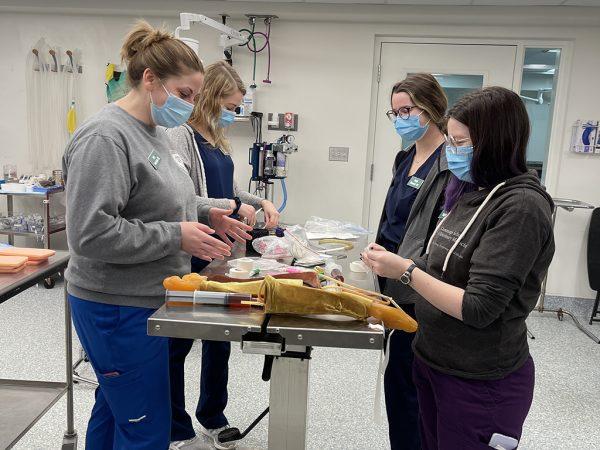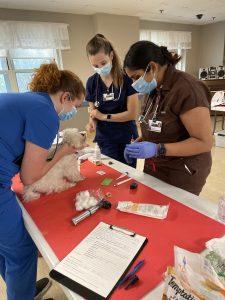-
About
- Leadership & Faculty
- News & Events
-
Academics
- Graduate
- Advanced Clinical Training
- Continuing Education
-
Student Life
-
-
Accommodations
- Our Campus
-
Accommodations
- Graduate Resources
-
-
Research
-
Hospitals & Clinics
- Emergency Care
- Hospital Services
-
Community Outreach
- Volunteer
Bridging the Gap Between Classroom and Clinic
Cummings School students have a wide variety of opportunities to translate classroom concepts into clinical practice

Classroom learning is a critical part of veterinary education, but it can be challenging for students to retain what they’ve learned due to the volume of information they consume.
“Students can learn a bunch of stuff for an exam and then it’s immediately purged from their minds,” says Emily McCobb V00, Director of Shelter and Community Medicine. “If we want them to retain that type of information, they will do better if the information is tied to a clinical experience.”
With this in mind, Cummings School students are offered a variety of opportunities throughout their four years to translate the concepts they learn in the classroom into hands-on clinical application.
For example, they practice inserting an IV or intubating a model animal in a simulation lab, conduct basic wellness exams and give vaccinations to actual patients, and participate in supervised spay and neuter procedures.
These activities give students in the pre-clinical years exposure to clinical settings to increase their comfort, confidence, and competence. “The idea is to provide a layering of experiences and to take the things they’re learning in the preclinical coursework and prepare them to function as a student clinician in the clinical years,” McCobb explains.
Students may perform spay and neuter surgeries as part of the Community Medicine program, which provides care for underserved animals in shelters, community cats, and for low-income pet owners.
“We have two goals, serving underserved animals in our community and giving our students practice-ready skills,” says McCobb.
Abby Cashel V24 has observed and participated in spay and neutering of feral community cats as part of her second-year clinical rotation.
“Every step, from induction to recovery, cemented classroom concepts and bettered my understanding of anatomy, pharmacology, physiology, and surgery,” Cashel says.
“In the operating room, I visualized the anatomy that I learned in my first-year course and understood how my surgical techniques can affect healing times and prevent infection. Experiences like these remind me of just how well my education is preparing me to enter my clinical rotations and eventually practice medicine for my own patients.”
Department:
DVM Program
